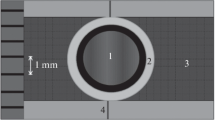Abstract—
We have studied ignition and structure formation processes in powder mixtures of refractory metals, Teflon, and energetic additives. Tungsten or tantalum has been used as a component of the mixtures in order to obtain high-density condensed products. Aluminum and zirconium have been used as energetic additives that lower the ignition temperature and raise the combustion temperature of the mixtures. The compositions studied have been chosen using thermodynamic calculations in order to maximize the amount of condensed products with a high combustion temperature. The mixtures were pressed into pellets. The heating rate of the crucible was varied. Experiments with the mechanically activated mixtures have shown an appreciable increase in the magnitude of the effect for both thermal and shock wave reaction initiation.










Similar content being viewed by others
REFERENCES
Ryabinin, Yu.I., Concerning some experiments on dynamic compression of matter, Zh. Tekh. Fiz., 1956, vol. 26, no. 12, pp. 26–61.
Batsanov, S.S., Inorganic chemistry of high dynamic pressures, Usp. Khim., 1986, no. 4, pp. 579–607.
Alder, B., Solids under Pressure, New York: McGraw-Hill, 1963, pp. 385–420.
Dremin, A.N. and Breusov, O.N., Processes induced in solids by strong shock waves, Usp. Khim., 1968, vol. 37, no. 5, pp. 898–916.
Boslough, M.B. and Graham, A.A., Submicrosecond shock-induced chemical reactions in solids: first real-time observations, Chem. Phys. Lett., 1985, vol. 121, nos. 4–5, pp. 446–452.
Thadhani, N.N., Shock-induced chemical reactions and synthesis of materials, Prog. Mater. Sci., 1993, vol. 37, no. 2, pp. 117–226.
Kanel’, G.I., Razorenov, S.V., Utkin, A.V., and Fortov, V.E., Udarno-volnovye yavleniya v kondensirovannykh sredakh (Shock-Wave-Induced Effects in Condensed Media), Moscow: Yanus-K, 1996.
Prummer, R., Explosivverdichtung pulvriger Substanzen, Berlin: Springer, 1987.
Krupin, A.V., Solov’ev, V.Ya., Popov, G.S., and Kr’’stev, M.R., Obrabotka metallov vzryvom (Explosion Processing of Materials), Moscow: Metallurgiya, 1991.
Kontseptsiya razvitiya samorasprostranyayushchegosya vysokotemperaturnogo sinteza kak oblasti nauchno-tekhnicheskogo progressa (Concept of the Development of Self-Propagating High-Temperature Synthesis as an Area of Science and Technology Progress), Merzhanov, A.G., Ed., Chernogolovka: Territoriya, 2003.
Khimiya sinteza szhiganiem (The Chemistry of Combustion Synthesis), Koizumi, M., Ed., Moscow: Mir, 1998.
Lin, E.E., Novikov, S.A., and Kuropatkin, V.G., Dynamic compaction of ultradisperse diamond, Fiz. Goreniya Vzryva, 1995, vol. 31, no. 5, pp. 136–138.
Zelepugin, S.A., Dolgoborodov, A.Yu., Ivanova, O.V., and Zelepugin, A.S., Udarno-volnovoi sintez v tverdykh smesyakh (Shock-Wave Synthesis in Solid Mixtures), Tomsk: IOA Sib. Otd. Ross. Akad. Nauk, 2012.
Vadchenko, S.G. and Alymov, M.I., Ignition of W–Teflon–Al powder mixtures, Int. J. Self-Propag. High-Temp. Synth., 2017, vol. 26, no. 2, pp. 137–139.
Alymov, M.I., Vadchenko, S.G., Saikov, I.V., and Kovalev, I.D., Shock wave processing of tungsten- and fluoropolymer-based powder mixtures, Perspekt. Mater., 2016, no. 11, pp. 55–60.
Baramboim, N.K., Mekhanokhimiya polimerov (Mechanochemistry of Polymers), Moscow: Rostekhizdat, 1961.
Gorokhovskii, G.A., Poverkhnostnoe dispergirovanie dinamicheski kontaktiruyushchikh polimerov i metallov (Surface Dispersion of Polymers and Metals in Dynamic Contact), Kiev: Naukova Dumka, 1972.
Malkin, A.I., Kiselev, M.R., Klyuev, V.A, Loznetsova, N.N., and Toporov, Yu.P., Effect of mechanical activation on the thermal properties of aluminum–Teflon powder mixtures, Materialovedenie, 2012, no. 3, pp. 10–14.
Boldyrev, V.V. et al., Fundamental’nye osnovy mekhanicheskoi aktivatsii, mekhanosinteza i mekhanokhimicheskikh tekhnologii (Fundamental Principles of Mechanical Activation, Mechanosynthesis, and Mechanochemical Technologies), Avvakumov, E.G., Ed., Novosibirsk: Sib. Otd. Ross. Akad. Nauk, 2009.
ACKNOWLEDGMENTS
This work was supported by the Presidium of the Russian Academy of Sciences (program no. 56) and carried out with the participation of the staff of the Yugra State University (project no. 13-01-20/28). In this study, we used equipment at the Distributed Shared Research Facilities Center, Merzhanov Institute of Structural Macrokinetics and Materials Science, Russian Academy of Sciences.
Author information
Authors and Affiliations
Corresponding author
Rights and permissions
About this article
Cite this article
Alymov, M.I., Vadchenko, S.G., Gordopolova, I.S. et al. Effect of Mechanical Activation on Thermally and Shock Wave Initiated Reactions of Refractory Metals with Teflon. Inorg Mater 54, 1175–1182 (2018). https://doi.org/10.1134/S0020168518110018
Received:
Accepted:
Published:
Issue Date:
DOI: https://doi.org/10.1134/S0020168518110018




